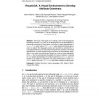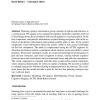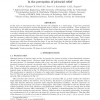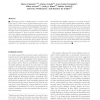CVPR
2011
IEEE
13 years 8 months ago
2011
IEEE
Many computer vision approaches take for granted positive answers to questions such as “Are semantic categories visually separable?” and “Is visual similarity correlated to ...
COMSIS
2010
13 years 9 months ago
2010
The focus of this paper is on crafting a new visual language for attribute grammars (AGs), and on the development of the associated programming environment. We present a solution f...
COGCOM
2010
13 years 9 months ago
2010
To decide ``Where to look next ?'' is a central function of the attention system of humans, animals and robots. Control of attention depends on three factors, that is, lo...
CMOT
2010
13 years 9 months ago
2010
Planning a path to a destination, given a number of options and obstacles, is a common task. We suggest a two-component cognitive model that combines retrieval of knowledge about t...
ICRA
2009
IEEE
13 years 10 months ago
2009
IEEE
In Simultaneous Localisation and Mapping (SLAM), it is well known that probabilistic filtering approaches which aim to estimate the robot and map state sequentially suffer from poo...
HVEI
2009
13 years 10 months ago
2009
In this study we demonstrate that touch decreases the ambiguity in a visual image. It has been previously found that visual perception of three-dimensional shape is subject to cer...
VL
2010
IEEE
13 years 10 months ago
2010
IEEE
Visual programming languages can be used to make computer science more accessible to a broad range of students. The evaluative focus of current research in the area of visual lang...
PRICAI
2010
Springer
13 years 10 months ago
2010
Springer
Abstract. Humans can associate vision and language modalities and thus generate mental imagery, i.e. visual images, from linguistic input in an environment of unlimited inflowing i...
JOCN
2010
13 years 11 months ago
2010
■ Following destruction or deafferentation of primary visual cortex (area V1, striate cortex), clinical blindness ensues, but residual visual functions may, nevertheless, persis...
PRL
2007
13 years 12 months ago
2007
This paper introduces a novel method of visual learning based on Genetic Programming, which evolves a population of individuals (image analysis programs) that process attributed v...







